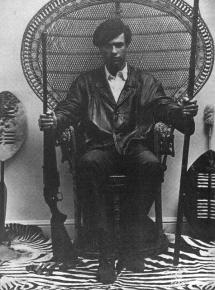The power to decide our destiny
reviews an exhibit about the hidden history of the Black Panther Party.
THE BLACK Panther Party was one of the most vibrant and influential revolutionary organizations in the U.S. It was also one of the most feared and despised by the American government.
FBI head J. Edgar Hoover called the party "the greatest threat to the internal security of the country." He oversaw the infamous program "COINTELPRO," and one of its main objectives was eliminating the influence and initiatives of the Black Panther Party. In city after city, the forces of the state unleashed a vicious and racist counter-organizing campaign of unlawful surveillance, eavesdropping, infiltration, police harassment and targeted assassinations of Black Panthers that ultimately brought the organization down.
A new exhibition at the DuSable Museum of African American History in Chicago titled, The Black Panthers: Making Sense of History, invites the viewer to learn about the politics and campaigns of the group through Panther Party propaganda and a series of original and candid photographs by Stephen Shames.

There are photos, lithographs, videos, official party newspapers and posters. The first gallery contains a poster explaining the meaning of the ubiquitous image of the Black Panther: The large black cat. It symbolizes courage, determination and freedom.
Huey P. Newton, a prominent leader of the Black Panther Party, and his brother Melvin composed the now iconic uniform the Panthers wore: blue shirt, black pants, black leather jacket, black beret tilted to the side and accessorized with an openly displayed, loaded shotgun.
There are courtroom sketches. Leaders and associates of the Black Panthers--Newton, Angela Davis and Bobby Seale--were arrested and tried in highly publicized trials. There was no Court TV in the 1960s, just an artist with paper and colored pencils. Much of the exhibition's memorabilia is words and images describing the campaigns to free Black Panther Party members from prison.
THE PANTHERS are probably most famous for the battle they waged to carry firearms openly. They argued that Blacks had the right to defend themselves from police violence and racist attacks. Panthers followed and monitored the police during arrests, and sometimes intervened. The original name of the group was the Black Panther Party for Self-Defense.
Photos show members patrolling neighborhoods. Other photos and documents chronicle the infamous 1967 incident when members went to the capital in Sacramento to protest the California State Assembly. Legislators were discussing the Mulford Act, which proposed a ban on public displays of loaded firearms. A group of Panthers walked into the legislative session, some argue by mistake, carrying guns. But it was perfectly legal at the time. Afterward, Bobby Seale and five others were arrested.
A copy of the Panther's "Ten-Point Program" is on display. This document lays out the social, political and economic demands of the party and disproves the claim that the Panthers were solely about guns.
The 10 points address myriad aspects of how the capitalist system oppresses Blacks. Number 1: We Want Freedom. We Want Power to Determine the Destiny of Black and Oppressed Communities. Other points demand full employment, decent housing and education, free health care, reforms in the criminal justice system, and an end to police brutality and wars of aggression abroad. It's a platform of ideas and causes that are still being fought for today.
The poster of the iconic image of a defiant Huey Newton in an oversized rattan chair with a spear in one hand and an M-1 rifle in the other is on display. The photo is as powerful today as the day it was taken and speaks volumes about the legacy of slavery and the tension between being African and American in a country constructed on racism.
The Black community lacked a social service infrastructure to meet the basic needs of people who were all too often refused services outside of their neighborhoods. So the Panthers started free breakfast programs to feed children and free health clinics. A Panther poster titled, "A Program for Survival," addressed the health care needs of people and included free medical, dental and optometry services.
Getting an ambulance in areas where poor Black people lived was a constant, life-threatening problem. The Panthers answer was to start an ambulance service. A leaflet explains: "The people's free ambulance program provides free, rapid transport for sick or injured people without time consuming checks into the financial status or means."
The cold-blooded assassination of Black Panther leader Fred Hampton by Chicago police and the FBI is explored in the show. He was shot and killed as he slept in his bed. Newspaper articles, gruesome photos, a jacket and the bullet-riddled door to his apartment are on display. The objects are a chilling, visceral reminder of how law enforcement used violent and illegal tactics to instill terror and wipe out the Black Panther Party.
No police officer or FBI agent was ever convicted. A video of a Democracy Now! interview with Jeffrey Haas, author of the new book The Assassination of Fred Hampton, reveals in full detail the government plot to execute Hampton and the subsequent cover-up.
The exhibition is a small slice of people's history in the tradition of the late radical historian Howard Zinn, which aims to challenge and inspire viewers to learn more about the Black Panther Party's rich, radical and controversial history. Check it out.


